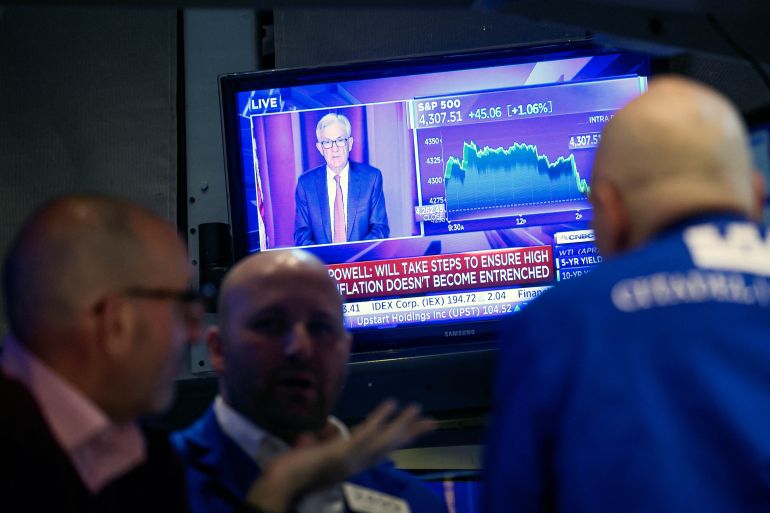US Fed hikes rates, signals aggressive stance to fight inflation
The quarter-percentage-point hike is likely the first of many to rein in the highest US inflation in more than 40 years.

The US Federal Reserve on Wednesday raised interest rates by a quarter percentage point and signalled that it would raise rates six more times in 2022 in an effort to fight the fastest inflation in 40 years.
The Fed is currently faced with a difficult task: Raise interest rates too quickly and risk tipping the United States economy into recession; raise interest rates too slowly and inflation could spiral out of control.
Keep reading
list of 4 itemsUS stocks surge after Fed announces rate hike
Powell backs 25-basis-point March rate hike
US stocks erase gains on hawkish Powell signals
Policymakers led by Fed Chair Jerome Powell voted 8-1 to raise the key interest rate to a target range of 0.25 percent to 0.5 percent. St Louis Fed President James Bullard dissented in favour of a half-point hike.
Following the decision, Powell told reporters that inflation is higher than expected and pledged to remain “nimble” in responding to new data and an evolving economic outlook.
“The economy is very strong and against the backdrop of an extremely tight labour market and high inflation, the Committee anticipates that ongoing increases in the target range for the federal funds rate will be appropriate,” Powell said.
He also stated that the Fed would begin reducing the size of its nearly $9 trillion balance sheet at an “upcoming meeting”.
In the Fed’s so-called dot plot, the median projection was for the benchmark rate to end 2022 at around 1.9 percent and then rise to around 2.8 percent in 2023.
Fed officials expect inflation to be higher than previously forecast, at 4.3 percent this year, but to fall to 2.3 percent in 2024.
Wednesday’s interest rate hike is the central bank’s first since 2018.
The Fed has kept borrowing costs near zero for two years to help the economy bounce back from the coronavirus pandemic. Vaccinations, the reopening of the economy and fiscal and monetary support all contributed to 2021 growth.
But the pandemic is not over, as new lockdowns in China demonstrate. The war in Ukraine also poses new and unexpected risk to global economic growth.
The Federal Open Market Committee said it is expecting the US economy to grow at a much slower rate in 2022, down from 4 percent to 2.8 percent. The economy is expected to grow 2.2 percent in 2023 and 2 percent in 2024.
Powell predicted that the labour market would remain strong and wages would continue to rise, adding that “employers are having difficulties filling job openings and wages are rising at their fastest pace in many years”.
Complicating things
Russia’s invasion of Ukraine has caused “tremendous” economic hardship and the implications for the US economy are “highly uncertain”, the committee said in its statement.
“The surge in prices of crude oil and other commodities that resulted from Russia’s invasion of Ukraine will put additional upward pressure on near-term inflation here,” Powell added.
The crisis in Ukraine and severe sanctions on Russia have recently sent commodities soaring. The cost of oil and gas, food and metals has gone up exponentially.
“We don’t have a perfect crystal ball about the future,” Powell told reporters.
US stock markets have been whipsawed in 2022, first from the looming interest rate hikes and now by the war in Ukraine.
After surging Wednesday morning, Wall Street dropped on the Fed’s announcement but then came roaring back before the closing bell.
Fresh data on Wednesday also showed that growth in US retail sales slowed in February after surging a month earlier. Home-builder sentiment also fell in March to a six-month low.
Workers are still sitting on the sidelines, causing businesses to chase the few who are available.